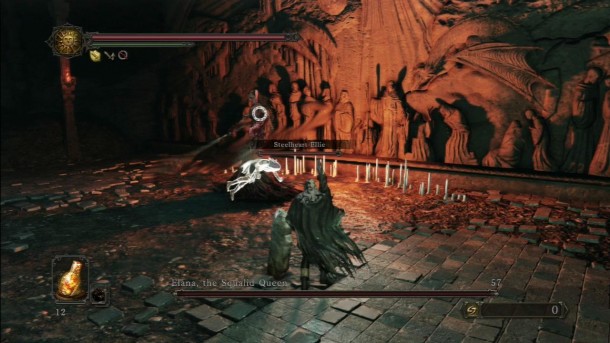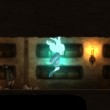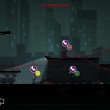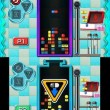Dark Souls II: Crown of the Sunken King Review
The road to the emotional rewards of the Souls games is strewn with sweat-stained controllers and saintly patience. The franchise as a whole is a long-term trust game, where any given boss shoves you to the precipice of capitulation, but never lets you go over the edge. I can't imagine that achieving this balance over and over again is an easy task for developer From Software, and there's a part of me that often fears I'm only one encounter away from giving up on the series. To its credit, that fear was pervasive during my playthrough of Crown of the Sunken King, the first of three content packs for Dark Souls II.
If you approach downloadable campaigns with a level of cynicism, take pleasure in knowing that Crown of the Sunken King does not feel like previously made content that was withheld for a cash grab. Its interconnected levels echo the woven layout of the first Dark Souls without feeling like a full-on throwback. You experience the tension of cautiously venturing along an unexplored path, only to realize that, much to your relief, you've stumbled upon a new shortcut to an old bonfire.
From Software builds on this positive sense of exploration with sets of environmental puzzles, some of which alter the shape of the landscape itself, letting you access new areas or attain items that are seemingly beyond reach. Once you learn that one puzzle leads you to unique treasure, the compulsion to solve every puzzle hits you like a broadsword. This encourages a level of thought and experimentation that Dark Souls II lacked. Ever the sadist studio, From Software uses this opportunity to subject you to new platforming challenges, as if to say, “Just one more thing…” Your dexterity is tested as often as your brain is, and in ways for which the main game provides little to no preparation. Crown of the Sunken King also differs from Dark Souls II stylistically. I relished in the dramatic reveal of a temple upon exiting the first cave in Shulva, Sanctum City. Held up against the European aesthetics of castles in Dark Souls II, the temple's Aztec influence is difficult to ignore, yet given the series' otherworldly look overall, the contrast is neither jarring nor off-putting.
Crown of the Sunken King is difficult and assumes you've made substantial progress in the main game. By placing its initial access point in Black Gulch, the add-on assumes you are conditioned for the trials of Shulva, Dragon's Sanctum, and Dragon's Rest. Given the series' infamy for its lack of hand-holding in the interest of personal discovery, I strongly advise you to explore a few other areas in the main game before venturing into these new lands. If you still question the add-on's high difficulty, wait until you meet the cousins of the poison statues from Black Gulch. That's assuming you haven't fallen into the game's myriad pits first.
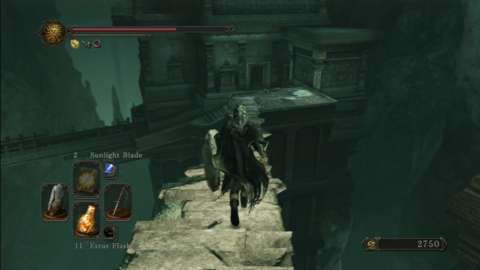
If you recall the dark and often unsettling areas that lead to Black Gulch, then you won't be surprised at the equally dreary locales in Crown of the Sunken King. This DLC introduces the grotesque insects known as the corrosive egg crawlers, whose bulbous silhouettes seldom fail to induce goose bumps if encountered in a poorly lit hallway. It's no wonder many Souls fans classify the series as survival horror.
The underlying weapon in this series has always been knowledge. Pairing that with awareness of your surroundings makes for a lethal combination. Much like in the rest of the series, combat in Crown of the Sunken King is at its most rewarding when you have the presence of mind to use your environment to your benefit. I would bear no shame in luring a couple of sanctum knights away from a narrow cliff ledge and onto a wide and flat arena-style platform if I felt it gave me an advantage. Yet sometimes, you just have to die to learn how each new opponent behaves. This was the case when I took on a pair of dragons and learned the hard way that it was in my best interest to separate them.
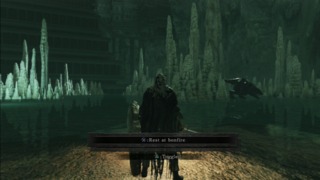
Your tactics against the bosses depend on how much Dark Souls II you've played up to this point. Crown of the Sunken King is guilty of having bosses who occasionally behave like reskins of other characters. Sinh closely resembles the ancient dragon, while Queen Elana could be mistaken for a sister of Queen Nashandra. The only boss encounter that has any semblance of originality is against a trio of human-size non-player characters. When you're dealing with three enemies, each with a different weapon skill, no two battles are alike. Your only hope is to make sense of the chaos and presume that each life you lose yields more knowledge of your enemies' moves and openings.
Dark Souls games demand two levels of patience: the kind born out of enduring a soul-crushing string of deaths and the kind of patience needed during actual combat. When considering the latter, I'm often inspired by the underappreciated Bushido Blade. Waiting for the opponent to move first and responding with an efficient, offensive reaction is often the best approach in any Souls game, and this is especially the case in Crown of the Sunken King. Much like the evil doppelgangers you've encountered in countless other games, a couple of knights in this DLC have movesets that are not unlike your own.
Dark Souls II by itself is so rich and robust in its challenges that I still feel the afterglow of having beaten it months ago. Yet that also comes with psychological scabs from the dozen replayed battles against the likes of the poison rat king and the smelter demon. As I began my eight-hour playthrough of Crown of the Sunken King, a line from The Shawshank Redemption echoed in my head: "And if you've come this far, maybe you're willing to come a little further." I was willing and, with every Souls playthrough to date, I have been rewarded accordingly. Crown of the Sunken King's standout exploratory design and abundance of engaging enemy encounters make it a terrific adventure, though a hair short of being essential. Equally significant is that it succeeds at raising the stakes for the next installment.

